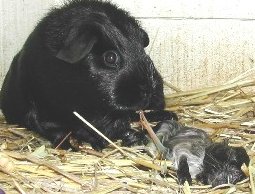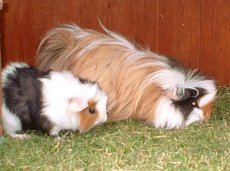Before you breed - Breeding cavies is risky and should not be undertaken lightly. Complications can and do occur that result in the loss of the mother and/or the babies. Think carefully before deciding to breed your piggie. Are you ready to give your girl extra special care throughout the pregnancy and the raising of the babies? Are you prepared to take her to the vet in the event of an emergency? Could you deal with the 24/7 responsibility of hand raising the babies if the mother died or rejected them? Do you have good homes for all of them? (The average litter has around 2-4 babies - however litters of 8+ have been reported) Finally, could you cope with the loss of your pig and/or her babies to complications, knowing that it was you who decided to breed them? If you answered "yes" to all of the questions above, it's time to do a bit of reading up on the subject. If you're going to put your piggie through something like that, it's only fair that you know exactly what you're doing. Reading this page is a start. There are also some links at the bottom of the page for you to check out as well.
Age to breed - The ideal age to breed a sow, or female guinea pig, is at 4-6 months. It is possible for her to become pregnant before then, but it is really hard on her small body and not a good idea at all. On the other hand, you shouldn't wait too long either. In many sows the pelvic bones stiffen at around 12 months if she hasn't been bred before making it hard to deliver the babies. This can result in dystocia - birthing complications - which can kill the sow and the babies. You shouldn't breed a cavy for the first time after she is 8 months old, but if she has been bred before then the stretching is permanent; you don't have to worry about her pelvic bones stiffening. The age of the boar doesn't matter as much, he can get a sow pregnant as early as three weeks old, and normally remains fertile for most of his life. A young to middle-aged boar, from around three months on up to around three years is your best bet.
Choosing a mate - The mate you choose for your guinea pig will depend on what you are breeding for. The health of both guinea pigs should be your primary concern. If you're trying to breed show-pigs, it's important that the parents have good characteristics matching the breed standard as closely as possible. Ideally, the father and mother should not be closely related. Inbreeding, or the breeding of closely related animals can result in weak or deformed offspring. Normally this isn't a problem if the inbreeding doesn't go very far; for instance, you may have a boar and a sow with especially good characteristics which you want to breed into your line and this is okay once in awhile. When you continuously mate related piggies that's when problems arise. Also it's very important if you're breeding a dalmatian or roan guinea pig to not mate them with another dalmatian or roan. Something about these particular genes mixing often results in severely deformed babies called "micros" who have to be put to sleep. Instead, pair your dalmatians and roans with self guinea pigs of matching color, who do not have any dalmatian or roan in their bloodline.
Putting them together - Introducing boars and sows is usually not a problem. Clean the cage up well so that it doesn't smell like either pig, and put them in together. A plate of veggies will help them to relax as they get to know each other. A little chasing and nipping is normal. You shouldn't worry about separating them unless there's any sign of blood (see the Social Life page.) Leave them together, and wait. You should usually be able to tell if the sow is pregnant when she is around 4-6 weeks into her pregnancy. She will begin to get pear shaped, and you will be able to feel the babies inside. They feel like hard, walnut sized lumps. As soon as you know for sure that she is pregnant, you should remove the boar. Sows can get pregnant again an hour after they give birth, which can be hard on them, so it's very important that the boar isn't with her when this happens. It's best to put her with another sow so she still has company, but if this is too stressful for her you can house her alone. This problem can be prevented by breeding in threes; two sows to a boar, that way you can just remove the boar when the sows are pregnant and they will still have each other's company. Only do this if you have places for all the babies though.
Pregnancy - A guinea pig's gestation is around 10 weeks, take or give a little, and it's very important that she has tip-top care through the whole thing. Signs of pregnancy may begin to show as soon as a month after the mating, but if it is a very small litter you may not be able to tell until shortly before she has the babies. She will begin to look pear-shaped, and you can feel little hard lumps in her belly about the size of a walnut. A balanced diet of hay and veggies is a must during this time (see the nutrition page) and it's also important that she is well exercised. (Many in-pig sows die from complications related to their being overweight.) A large cage and another sow to play with will help with this. Also you can try putting the water bottle on one side of the cage and the food dish on the other, so she has to move around to eat and drink. Try to avoid handling her as much as possible as she gets into the later stages of pregnancy. You could injure her or the babies. When you do handle her, be sure to support her tummy carefully.
© Michelle 2004 - click here to visit Michelle's site |
 |
Birth - You can tell the birth is getting close when the pelvic bones (down near the genitals) start to separate and when the babies begin to grind their teeth. When the pelvic bones are two finger's widths apart, she will usually have her babies in 24 to 48 hours, but some stubborn piggies have taken up to a two weeks! Keep a close eye on her during this stage, and you may see the birth. She will start having contractions (it looks like she is hiccupping) and normally a few minutes later the babies will start to come. She should tear off the sacks, stimulate the babies to start breathing, and cut the umbilical cords herself without any help from you. Only if you see that she isn't doing what she should be should you break in and help. She will want to eat the afterbirth; let her, it is very nutritious and will help her with milk production. The entire birth shouldn't take much longer than 30 minutes, or at the most 15 minutes between each baby, longer than this may mean she's having complications and she should be taken to a vet immediately. Baby guinea pigs are born fully furred and with their eyes open and will be up and running about shortly after the birth.
© Michelle 2004 - click here to visit Michelle's site |
 |
The babies - Mom will do everything that is needed in taking care of the babies. Just provide her with plenty of food. When they're 3 weeks old, the babies will be weaned and they will start becoming fertile. At this age you should sex them and separate the males so they don't get the girls pregnant. It's usually best to wait till they're at least 6-8 weeks old to rehome them so they are more independent and used to living without mom.
 |
Complications - There are serious complications that can occur during pregancy, birth, and shortly after birth and you need to know how to recognize them so you can get your piggie the proper care as soon as possible. Toxemia is a serious problem that occurs in the later stages of pregancy, especially with inactive/overweight sows. A toxic sow will stop eating and become listless and lethargic. Her eyes will be sunken and her coat ruffled and messy, and she will probably be hiding in a corner of the cage. The babies inside won't be active either. Also, the sow will smell like acetone (nail polish remover.) Your sow's only hope once she has toxemia is immediate veterinary treatment. Sometimes not even this will save her. You can help to prevent toxemia by keeping your pig on a balanced diet and making sure she gets plenty of exercise. That's why it's important for her to have a big cage and a friend to play with. Dystocia is a difficult birth. Squealing during contractions and repeated straining without having a baby are signs of dystocia. You should take your cavy to a vet immediately. The longer she goes without treatment, the more likely it is that neither she or the babies will make it. A prolapsed uterus is when the sow's contractions actually begin to push the uterus outside her body. She must be taken to the vet immediately to have it put back or she will die. A sow can also retain fetuses, so it's always a good idea to check and make sure there are no babies in her belly after she is finished with labor. If there is, a trip to the vet is a must.
These are only a few of the problems that can occur, so if you suspect that there is anything wrong with your pregnant or lactating sow, or any piggie for that matter, do not hesitate to bring her to a knowledgable cavy vet as soon as possible. It could save her and the babies' life.